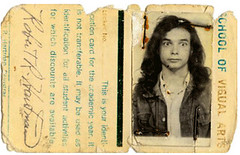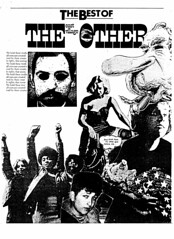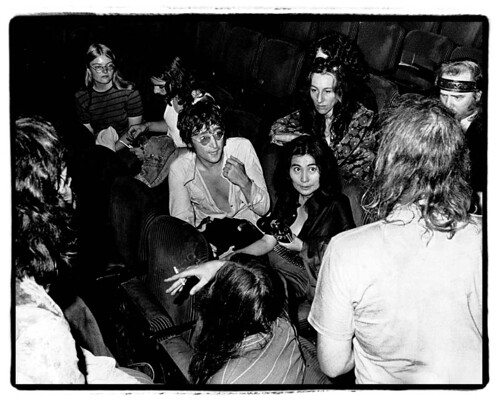In Larry “Ratso” Sloman’s 1998 book, “Steal This Dream: Abbie Hoffman and the Counter-Culture Revolution in America,” he recounts what happened the day Abbie Hoffman dragged him and Peter Leggieri out of the East Village Other office to witness the Yippie icon’s attack on Wall Street. Mr. Sloman was a lowly EVO intern at the time who credits the paper with giving him his start as a writer. The excerpt is reprinted here with the author’s permission.
Read more…
BILL GRAHAM
Larry ‘Ratso’ Sloman: EVO and Abbie Hoffman’s Occupy Wall Street
By LARRY SLOMANCoca Crystal: Handmaiden, Slum Goddess, Reporter
By COCA CRYSTALCoca Crystal (born Jackie Diamond) was EVO’s self-described “gatekeeper,” receptionist, sometime reporter and sometime model until the bitter end, when, as staff and resources dwindled, she became its defacto publisher (she financed the final two issues out of her own purse). Here, she describes how she got her start.
The first time I set foot in the EVO office, it was in the fall of 1969 and I had come to visit with a college friend, Barbara, who was EVO’s secretary.
The office was located on the third floor of the Fillmore East building on Second Avenue and Sixth Street. The place was a wreck. It was freezing, the garbage cans were overflowing, cigarette butts were everywhere, and the walls were covered in fabulous cartoons by the best in underground comix: R. Crumb, Kim Deitch, Spain Rodriguez, Yossarian, Shelton, Art Spiegelman, just to name a few. It was chaos, but a kind of cool chaos.
The office was in a frenzy to get copy ready for the typesetter, and I was asked if I could type. I said I could and was given the job of typing up the classifieds. I had never seen such weird ads. (“Dominant Iguana seeks submissive zebra,” sex ads, odd employment opportunities, legal advice for pot busts). I had to type while sitting on Allen Katzman’s lap (his idea), wearing my winter coat and gloves. When I had completed the classifieds I was told the other secretary, Marcia, was leaving and I could have her job if I wanted it. The pay was $35 a week. I took the job. Read more…
Steve Kraus: How Green Was My Underground
By STEVE KRAUSAs documented in a DNA Info video, Steve Kraus has been publishing the New York Good News since the 1960s. Now 82, he has lived just above Café Mogador on St. Marks Place for the past 37 years. He also volunteers for the Jewish Foundation of the Righteous. The following piece appeared in a 1979 booklet produced by the Alternative Press Syndicate, titled “Alternative Media: How the Muckrakers Saved America,” published by Bell and Howell. It is reprinted here with the author’s permission.
Steve Kraus – How Green Was My Underground
For more on “Blowing Minds: The East Village Other, the Rise of Underground Comix and the Alternative Press, 1965-72,” read about the exhibition here, and read more from EVO’s editors, writers, artists, and associates here.
Steven Heller’s Dada
By STEVEN HELLERRobert Hughes once described the weekly paste-up night at The East Village Other as “a Dada experience.” The year was 1970 and while none of us who were toiling into the wee hours of the morning at one of America’s oldest underground papers (founded in 1965) knew what he was talking about, we nevertheless assumed that to get Time’s then newly appointed art critic to spend some of his first weeknights in America with us, we were doing something weird and perhaps even important. “Dada was the German anti-art political-art movement of the 1920s,” he explained in his cool Australian accent. “And this is the closest thing I’ve come to seeing it recreated today. I’m really grateful for the chance to be here.”
Yet he needn’t have been so grateful. He was as welcome as any other artist, writer, musician, hanger-on and at that moment, detective Frank Serpico, the most famous whistle-blowing cop in America, was stationed at the local Ninth Precinct and would came around periodically in his various undercover costumes to schmooze with the EVO staffers. Paste-up night was open to anybody who drifted up to the dark loft above Bill Graham’s Fillmore East, a former Loews Theater turned rock palace on Second Avenue and Sixth Street, just next door to Ratner’s famous dairy restaurant, in a neighborhood that in the Thirties was the heart of New York’s Yiddish Theater. At that time it was the East Coast hippie capital.
Beginning at seven or eight o’clock at night and lasting until dawn, the regular and transient layout staff took the jumble of counterculture journalism and anti-establishment diatribe that was the paper’s editorial meat and threw it helter skelter onto layouts that were pretty anarchic. Anyone could join in whether they had graphic design experience or not, yet many of the gadfly layout artists were too stoned to complete their pages which were finished on the long subway ride to the printer deep inside Brooklyn. Read more…
Allen Katzman and J.C. Suares on the Reportage of Wonderment
By BROOKE KROEGERWith this special edition, The Local presents the first of seven wild, winding, weekend walks through the seven years when this neighborhood was home to The East Village Other. EVO, as the weekly soon became known, began in the imagination of the late Walter Bowart, in his fourth-floor painter’s loft at Avenue B and Second Street. He was the sole creator of Issue No. 1, a broadside, or uncut proof sheet, that was folded into tabloid size. As readers unfolded it again, the pages faced all directions. Anyone with half an eye who happened to pass a Village newsstand that October of 1965, could see that Mr. Bowart was far ahead of others in grasping the real potential of the revolution in printing techniques just getting underway: the move from costly metal plates, professional printers, and “hot type” to paper, scissors and rubber cement. Cold type — offset printing — did more than lower the bar to entry; it provided whole new means of expression in graphics and text.
By Issue No. 2, the East Village Other had a team of publishers and actual papers of incorporation. By Issue No. 3, it had its own storefront office on Avenue A between Ninth and Tenth Streets, just across from Tompkins Square Park. In 1968, Bill Graham bartered concert ads for office space on the third floor of his new Fillmore East, giving EVO daily access to the concert hall’s all-important back stairwell and the stars of rock ‘n’ roll.
By the time the Fillmore closed in 1971, EVO’s end was not far behind. It had moved to new offices on the 11th floor of 20 East 12th Street, and then to a back store room of the Law Commune offices at 640 Broadway. There, as word surfaced that, owing to unpaid bills, city marshals were coming to seize whatever assets might be, the young Charlie Frick, alone in the office with Coca Crystal, scooped up all and sundry, boxed up the files, commandeered his family truck and then hauled it all to his mother’s barn in Passaic County, N.J. There it would remain unmolested for the next few decades.
In anticipation of The Local’s exhibition “Blowing Minds: The East Village Other, the Rise of Underground Comix and the Alternative Press, 1965-72,” we asked Mr. Frick to dive back into the bounty, now variously housed in a storage unit and at his home in Montclair, N.J. Choice selections from the ephemera and artifacts he and others have unearthed will be among items to be featured.
The Local has something from the annals, too. The items in Mr. Frick’s collection included the following undated typescript that must have come into his possession at some point at least a decade after EVO’s demise. It is a xerox of a proposal for a book to be titled “The Best of the East Village Other.” Its cover page attributes it to the late Allen Katzman (most likely the proposal’s author) and the well-known creative consultant and book and magazine designer, J.C. Suares. The late Mr. Katzman, a poet and longtime publisher of EVO, was, along with Mr. Bowart and Dan Rattiner, a signatory to the founding papers. Who better than he to start us out?
Viewfinder | The Fillmore East
By AMALIE R. ROTHSCHILDEarlier today, we wrote about the Fillmore East, one of the more remarkable properties within the confines of a proposed landmark district. The unofficial house photographer of the Fillmore East, Amalie R. Rothschild, shared her photos and memories from the theater’s brief yet influential existence from 1968 to 1971. — Stephen Rex Brown
Read more…
Looking Back | The Fillmore East
By STEPHEN REX BROWN Amalie R. Rothschild A huge crowd formed around the Fillmore East in May 1970 when tickets went on sale for Crosby, Stills, Nash and Young.
Amalie R. Rothschild A huge crowd formed around the Fillmore East in May 1970 when tickets went on sale for Crosby, Stills, Nash and Young.The push to preserve blocks of the neighborhood through a landmark district has, not surprisingly, led to a lot of conversations about the history of the area. The proposed district covers roughly six blocks, and perhaps no property within the tract has hosted more important figures in American culture than the former Fillmore East building at 105 Second Avenue.
Now, the entrance to the building is an Emigrant Savings Bank, and the 2,600-seat theater has been replaced with an apartment building. But the Fillmore’s three-year existence had a lasting impact culturally; Jimi Hendrix, Joe Cocker and Miles Davis all recorded well-regarded live albums there. The Who played their rock opera, “Tommy” in its entirety for the first time in the United States in 1969 at the Fillmore East. And the first rock concert to be broadcast on television was taped there in 1970.
But the Fillmore’s impact went beyond the performers onstage. Numerous technological innovations during the theater’s short existence were adopted at concert venues across the country.
“I was blown away by what a creative, experimental theater environment there was at the Fillmore East,” said Amalie R. Rothschild, a photographer who was among the many NYU students who landed dream jobs at the Fillmore when it opened in 1968. “It was a real place to do real things. The students had a live laboratory within which to work.”
Read more…









